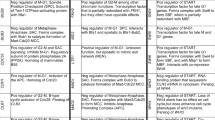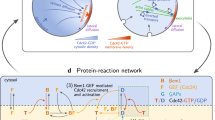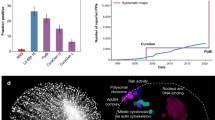Abstract
The establishment of cell polarity is an essential process for the development of multicellular organisms and the functioning of cells and tissues. Here, we combine large-scale protein interaction mapping with systematic phenotypic profiling to study the network of physical interactions that underlies polarity establishment and maintenance in the nematode Caenorhabditis elegans. Using a fragment-based yeast two-hybrid strategy, we identified 439 interactions between 296 proteins, as well as the protein regions that mediate these interactions. Phenotypic profiling of the network resulted in the identification of 100 physically interacting protein pairs for which RNAi-mediated depletion caused a defect in the same polarity-related process. We demonstrate the predictive capabilities of the network by showing that the physical interaction between the RhoGAP PAC-1 and PAR-6 is required for radial polarization of the C. elegans embryo. Our network represents a valuable resource of candidate interactions that can be used to further our insight into cell polarization.
This is a preview of subscription content, access via your institution
Access options
Subscribe to this journal
Receive 12 print issues and online access
$209.00 per year
only $17.42 per issue
Buy this article
- Purchase on Springer Link
- Instant access to full article PDF
Prices may be subject to local taxes which are calculated during checkout






Similar content being viewed by others
References
Humbert, P. O. et al. Control of tumourigenesis by the Scribble/Dlg/Lgl polarity module. Oncogene 27, 6888–6907 (2008).
Tepass, U. The apical polarity protein network in Drosophila epithelial cells: regulation of polarity, junctions, morphogenesis, cell growth, and survival. Annu. Rev. Cell Dev. Biol. 28, 655–685 (2012).
St Johnston, D. & Ahringer, J. Cell polarity in eggs and epithelia: parallels and diversity. Cell 141, 757–774 (2010).
Jacob, L., Opper, M., Metzroth, B., Phannavong, B. & Mechler, B. M. Structure of the l(2)gl gene of Drosophila and delimitation of its tumor suppressor domain. Cell 50, 215–225 (1987).
Woods, D. F. & Bryant, P. J. The discs-large tumor suppressor gene of Drosophila encodes a guanylate kinase homolog localized at septate junctions. Cell 66, 451–464 (1991).
Bilder, D. & Perrimon, N. Localization of apical epithelial determinants by the basolateral PDZ protein Scribble. Nature 403, 676–680 (2000).
Goehring, N. W. & Grill, S. W. Cell polarity: mechanochemical patterning. Trends Cell Biol. 23, 72–80 (2013).
Rodriguez-Boulan, E. & Macara, I. G. Organization and execution of the epithelial polarity programme. Nat. Rev. Mol. Cell Biol. 15, 225–242 (2014).
Boxem, M. et al. A protein domain-based interactome network for C. elegans early embryogenesis. Cell 134, 534–545 (2008).
Vidalain, P.-O., Boxem, M., Ge, H., Li, S. & Vidal, M. Increasing specificity in high-throughput yeast two-hybrid experiments. Methods 32, 363–370 (2004).
Walhout, A. J. & Vidal, M. A genetic strategy to eliminate self-activator baits prior to high-throughput yeast two-hybrid screens. Genome Res. 9, 1128–1134 (1999).
Cho, A. et al. WormNet v3: a network-assisted hypothesis-generating server for Caenorhabditis elegans. Nucleic Acids Res. 42, W76–W82 (2014).
Braun, P. et al. An experimentally derived confidence score for binary protein–protein interactions. Nat. Methods 6, 91–97 (2009).
Rolland, T. et al. A proteome-scale map of the human interactome network. Cell 159, 1212–1226 (2014).
Waaijers, S., Koorman, T., Kerver, J. & Boxem, M. Identification of human protein interaction domains using an ORFeome-based yeast two-hybrid fragment library. J. Proteome Res. 12, 3181–3192 (2013).
Eyckerman, S. et al. Design and application of a cytokine-receptor-based interaction trap. Nat. Cell Biol. 3, 1114–1119 (2001).
Lemmens, I., Lievens, S. & Tavernier, J. MAPPIT, a mammalian two-hybrid method for in-cell detection of protein–protein interactions. Methods Mol. Biol. 1278, 447–455 (2015).
Simonis, N. et al. Empirically controlled mapping of the Caenorhabditis elegans protein–protein interactome network. Nat. Methods 6, 47–54 (2009).
Stetak, A., Hörndli, F., Maricq, A. V., van den Heuvel, S. & Hajnal, A. Neuron-specific regulation of associative learning and memory by MAGI-1 in C. elegans. PLoS ONE 4, e6019 (2009).
Gunsalus, K. C. et al. Predictive models of molecular machines involved in Caenorhabditis elegans early embryogenesis. Nature 436, 861–865 (2005).
Boulton, S. J. et al. Combined functional genomic maps of the C. elegans DNA damage response. Science 295, 127–131 (2002).
Tu, Z. et al. Integrating siRNA and protein–protein interaction data to identify an expanded insulin signaling network. Genome Res. 19, 1057–1067 (2009).
Wang, L., Tu, Z. & Sun, F. A network-based integrative approach to prioritize reliable hits from multiple genome-wide RNAi screens in Drosophila. BMC Genomics 10, 220 (2009).
Wildwater, M., Sander, N., de Vreede, G. & van den Heuvel, S. Cell shape and Wnt signaling redundantly control the division axis of C. elegans epithelial stem cells. Development 138, 4375–4385 (2011).
Winter, J. F. et al. Caenorhabditis elegans screen reveals role of PAR-5 in RAB-11-recycling endosome positioning and apicobasal cell polarity. Nat. Cell Biol. 14, 666–676 (2012).
Grant, B. & Hirsh, D. Receptor-mediated endocytosis in the Caenorhabditis elegans oocyte. Mol. Biol. Cell 10, 4311–4326 (1999).
Balklava, Z., Pant, S., Fares, H. & Grant, B. D. Genome-wide analysis identifies a general requirement for polarity proteins in endocytic traffic. Nat. Cell Biol. 9, 1066–1073 (2007).
Maniar, T. A. et al. UNC-33 (CRMP) and ankyrin organize microtubules and localize kinesin to polarize axon-dendrite sorting. Nat. Neurosci. 15, 48–56 (2012).
Wu, X., Pang, E., Lin, K. & Pei, Z.-M. Improving the measurement of semantic similarity between gene ontology terms and gene products: insights from an edge- and IC-based hybrid method. PLoS ONE 8, e66745 (2013).
Gottfried, I., Ehrlich, M. & Ashery, U. The Sla2p/HIP1/HIP1R family: similar structure, similar function in endocytosis? Biochem. Soc. Trans. 38, 187–191 (2010).
Parker, J. A. et al. Huntingtin-interacting protein 1 influences worm and mouse presynaptic function and protects Caenorhabditis elegans neurons against mutant polyglutamine toxicity. J. Neurosci. 27, 11056–11064 (2007).
Liu, J. et al. The C. elegans SYS-1 protein is a bona fide β-catenin. Dev. Cell 14, 751–761 (2008).
Phillips, B. T., Kidd, A. R., King, R., Hardin, J. & Kimble, J. Reciprocal asymmetry of SYS-1/beta-catenin and POP-1/TCF controls asymmetric divisions in Caenorhabditis elegans. Proc. Natl Acad. Sci. USA 104, 3231–3236 (2007).
Cuppen, E., van der Linden, A. M., Jansen, G. & Plasterk, R. H. A. Proteins interacting with Caenorhabditis elegans Galpha subunits. Comp. Funct. Genomics 4, 479–491 (2003).
Hoege, C. et al. LGL can partition the cortex of one-cell Caenorhabditis elegans embryos into two domains. Curr. Biol. 20, 1296–1303 (2010).
Beatty, A., Morton, D., Kemphues, K. & The, C. elegans homolog of Drosophila Lethal giant larvae functions redundantly with PAR-2 to maintain polarity in the early embryo. Development 137, 3995–4004 (2010).
Khan, L. A. et al. Intracellular lumen extension requires ERM-1-dependent apical membrane expansion and AQP-8-mediated flux. Nat. Cell Biol. 15, 143–156 (2013).
Göbel, V., Barrett, P. L., Hall, D. H. & Fleming, J. T. Lumen morphogenesis in C. elegans requires the membrane-cytoskeleton linker erm-1. Dev. Cell 6, 865–873 (2004).
Armenti, S. T., Chan, E. & Nance, J. Polarized exocyst-mediated vesicle fusion directs intracellular lumenogenesis within the C. elegans excretory cell. Dev. Biol. 394, 110–121 (2014).
Berkowitz, L. A. & Strome, S. MES-1, a protein required for unequal divisions of the germline in early C. elegans embryos, resembles receptor tyrosine kinases and is localized to the boundary between the germline and gut cells. Development 127, 4419–4431 (2000).
Bei, Y. et al. SRC-1 and Wnt signaling act together to specify endoderm and to control cleavage orientation in early C. elegans embryos. Dev. Cell 3, 113–125 (2002).
Hoffmann, M., Segbert, C., Helbig, G. & Bossinger, O. Intestinal tube formation in Caenorhabditis elegans requires vang-1 and egl-15 signaling. Dev. Biol. 339, 268–279 (2010).
Honnen, S. J. et al. C. elegans VANG-1 modulates life span via insulin/IGF-1-like signaling. PLoS ONE 7, e32183 (2012).
Sanchez-Alvarez, L. et al. VANG-1 and PRKL-1 cooperate to negatively regulate neurite formation in Caenorhabditis elegans. PLoS Genet. 7, e1002257 (2011).
Anderson, D. C., Gill, J. S., Cinalli, R. M. & Nance, J. Polarization of the C. elegans embryo by RhoGAP-mediated exclusion of PAR-6 from cell contacts. Science 320, 1771–1774 (2008).
Chan, E. & Nance, J. Mechanisms of CDC-42 activation during contact-induced cell polarization. J. Cell Sci. 126, 1692–1702 (2013).
Chevray, P. M. & Nathans, D. Protein interaction cloning in yeast: identification of mammalian proteins that react with the leucine zipper of Jun. Proc. Natl Acad. Sci. USA 89, 5789–5793 (1992).
Vidal, M., Brachmann, R. K., Fattaey, A., Harlow, E. & Boeke, J. D. Reverse two-hybrid and one-hybrid systems to detect dissociation of protein–protein and DNA-protein interactions. Proc. Natl Acad. Sci. USA 93, 10315–10320 (1996).
Yu, H. et al. High-quality binary protein interaction map of the yeast interactome network. Science 322, 104–110 (2008).
Schiestl, R. H. & Gietz, R. D. High efficiency transformation of intact yeast cells using single stranded nucleic acids as a carrier. Curr. Genet. 16, 339–346 (1989).
Ewing, B., Hillier, L., Wendl, M. C. & Green, P. Base-calling of automated sequencer traces using phred. I. Accuracy assessment. Genome Res. 8, 175–185 (1998).
Hibbs, M. A. et al. Exploring the functional landscape of gene expression: directed search of large microarray compendia. Bioinformatics 23, 2692–2699 (2007).
R Core Team R: A Language and Environment for Statistical Computing (R Foundation for Statistical Computing, 2014); http://www.R-project.org.
Lin, Y.-C. et al. Genome dynamics of the human embryonic kidney 293 lineage in response to cell biology manipulations. Nat. Commun. 5, 4767 (2014).
Brenner, S. The genetics of Caenorhabditis elegans. Genetics 77, 71–94 (1974).
Lamesch, P. et al. C. elegans ORFeome version 3.1: increasing the coverage of ORFeome resources with improved gene predictions. Genome Res. 14, 2064–2069 (2004).
Fraser, A. G. et al. Functional genomic analysis of C. elegans chromosome I by systematic RNA interference. Nature 408, 325–330 (2000).
D’Agostino, I., Merritt, C., Chen, P.-L., Seydoux, G. & Subramaniam, K. Translational repression restricts expression of the C. elegans Nanos homolog NOS-2 to the embryonic germline. Dev. Biol. 292, 244–252 (2006).
Praitis, V. Creation of transgenic lines using microparticle bombardment methods. Methods Mol. Biol. 351, 93–107 (2006).
Schonegg, S. & Hyman, A. A. CDC-42 and RHO-1 coordinate acto-myosin contractility and PAR protein localization during polarity establishment in C. elegans embryos. Development 133, 3507–3516 (2006).
Orchard, S. et al. The MIntAct project–IntAct as a common curation platform for 11 molecular interaction databases. Nucleic Acids Res. 42, D358–D363 (2014).
Acknowledgements
We thank M. Zerial for providing the MZE1 strain, C. Bargmann for providing strain CX9797 and a strain carrying the Pdes-2::myristoyl::GFP extrachromosomal array, and M. Harterink for strain STR62. We thank S. de Rouck for technical assistance, and M. Vidal for permission to reanalyse MAPPIT data. We thank F. Zwartkruis, M. Gloerich and A. Thomas for critically reading the manuscript. Some nematode strains used in this work were provided by the Caenorhabditis Genetics Center, which is funded by the NIH National Center for Research Resources (NCRR). This work was supported by the Netherlands Organization for Scientific Research (NWO) ALW Innovational Research Incentives Scheme Vidi grant 864.09.008 to M.B., NWO-CW ECHO grant 711.014.005 to M.B., National Science Foundation Graduate Research Fellowship 12-A0-00-000165-01 to D.K., and NIH grants R01GM078341 and R01GM098492 to J.N. J.T. is the recipient of ERC Advanced Grant 340941.
Author information
Authors and Affiliations
Contributions
M.v.d.V. contributed to the cloning and Y2H screens. D.K. performed the PAC-1 rescue experiments. I.L. performed the MAPPIT experiments. J.J.R. and S.N. contributed to the RNAi screens. M.B. performed the computational analyses. All other experiments were performed by T.K. S.v.d.H. and T.K. contributed to the design of the study. J.N. contributed to the design of the PAC-1 PAR-6 experiments. J.T. contributed to the design of the MAPPIT experiments. T.K. and M.B. wrote the manuscript. M.B. guided all aspects of the study.
Corresponding author
Ethics declarations
Competing interests
The authors declare no competing financial interests.
Integrated supplementary information
Supplementary Figure 1 Enrichment of shared Gene Ontology (GO) terms and similar expression profiles in interacting protein pairs compared to control networks generated by replacing the prey proteins with random proteins from the search space.
(a) GO similarity scores for interacting protein pairs identified using the AD-cDNA library. Semantic similarity scores for the BP component of GO were calculated using the HRSS software package, which scores protein pairs on a scale of 0 (dissimilar GO terms) to 1 (similar GO terms)29. (b) Same as (a), but for interactions identified using the AD-Fragment scores. Due to the already high semantic similarity scores for pairs in the search space (749 genes involved in early embryonic development), enrichment scores are less high than for AD-cDNA derived interactions. Control network bars represent the mean of 100,000 control networks ± s.d. Statistical significance is the fraction of control networks that displayed the same or higher fraction of pairs with a particular GO similarity range as the actual interaction network. Protein pairs in the interaction network are depleted for pairs with a low semantic similarity score, and enriched for pairs with a high similarity score. (c–f) Average Pearson correlation coefficient (PCC) score of mRNAs corresponding to protein pairs in the indicated interaction datasets (red arrows), compared with the distribution of average PCC scores of 100,000 control networks generated by replacing the bait proteins with random proteins from the search space (blue line). PCC values were calculated using the compendium of expression microarray data collected in Wormbase release WS236. Statistical significance is the fraction of control networks that displayed an average PCC score identical or higher than the actual interaction network. As observed previously9, early embryogenesis genes already have such similar expression profiles that no further enrichment can be observed for interactions derived from the AD-Fragment library.
Supplementary Figure 2 Western blots for all protein pairs testing positive by co-affinity purification.
For every pair, three blots are shown. Top: detection of GFP-tagged proteins that co-purify with biotinylated mCherry-tagged proteins using an anti-GFP antibody. Middle: detection of GFP-tagged proteins in total lysates using an anti-GFP antibody. Bottom: detection of biotinylated Avi-mCherry tagged proteins in total lysates using streptavidin coupled to horse radish peroxidase. Protein pairs tested are indicated above the blots. The first protein listed is the Avi-mCherry tagged bait. Also indicated is whether the prey protein tested was full-length (f.l.) or corresponds to a shorter fragment (frag.). In all blots, lanes 1 and 2 are negative controls, and lane 3 is the actual affinity purification (1: Avi-mCherry-bait vs. EGFP alone, 2: Avi-mCherry alone vs. EGFP-tagged prey, 3: Avi-mCherry-bait versus EGFP-prey). The ∼35 kDa band in lanes 2 of the upper blots is due to cross-reactivity of the anti-GFP antibody with the highly abundant Avi-mCherry polypeptide. Asterisks indicate bands of expected molecular mass. Purifications were performed once. Unprocessed scans are shown in Supplementary Fig. 5.
Supplementary Figure 3 Graphical representation of every protein in the interaction network and the MRIs identified for that protein.
Grey boxes are full-length proteins. Predicted domains are shown as boxes of various colors and shapes. Identified MRIs are shown as yellow lines above the protein graphic. Protein names above each MRI indicate which proteins bind to that particular region.
Supplementary Figure 4 Analysis of MRIs.
(a–c) Distributions of MRI lengths expressed as the percentage of the corresponding full-length protein. (d–f) Distributions of absolute MRI lengths in amino acid residues. (a,d) MRIs identified for the bait proteins. (b,e) MRIs identified for the prey proteins from AD-Fragment library derived clones. (c,f) MRIs identified for the prey proteins from AD-cDNA library derived clones. (g) Graphical representations of all MRIs where interaction sites had previously been identified in the literature. Grey boxes are full-length proteins. Predicted domains are shown as boxes of various colors and shapes. Identified MRIs are shown as yellow lines above the protein graphic. Interaction sites from the literature are shown as blue lines above the protein graphic. In cases where the literature describes an interaction domain for a non-C. elegans protein, the corresponding site in the C. elegans protein is shown.
Supplementary information
Supplementary Information
Supplementary Information (PDF 6532 kb)
Supplementary Table 1
Supplementary Information (XLSX 48 kb)
Supplementary Table 2
Supplementary Information (XLSX 61 kb)
Supplementary Table 3
Supplementary Information (XLSX 45 kb)
Supplementary Table 4
Supplementary Information (XLSX 21 kb)
Supplementary Table 5
Supplementary Information (XLSX 118 kb)
Supplementary Table 6
Supplementary Information (XLSX 104 kb)
Supplementary Table 7
Supplementary Information (XLSX 40 kb)
Supplementary Table 8
Supplementary Information (XLSX 9 kb)
Supplementary Table 9
Supplementary Information (XLSX 16 kb)
Rights and permissions
About this article
Cite this article
Koorman, T., Klompstra, D., van der Voet, M. et al. A combined binary interaction and phenotypic map of C. elegans cell polarity proteins. Nat Cell Biol 18, 337–346 (2016). https://doi.org/10.1038/ncb3300
Received:
Accepted:
Published:
Issue Date:
DOI: https://doi.org/10.1038/ncb3300



